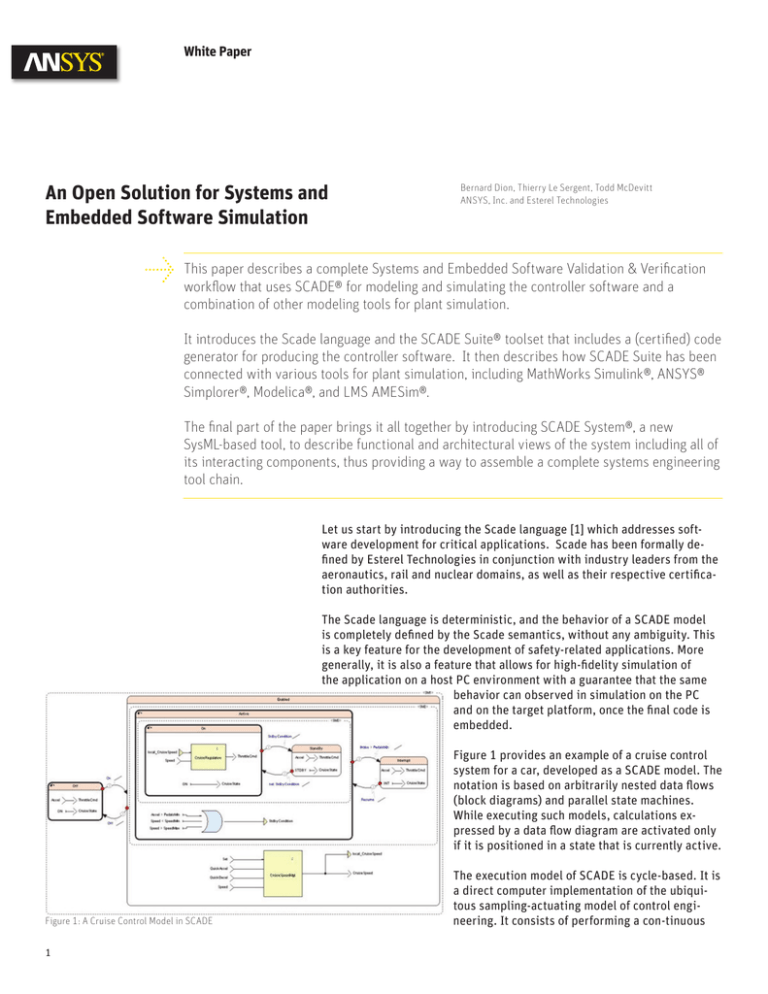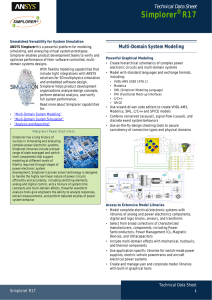
White Paper
An Open Solution for Systems and
Embedded Software Simulation
Bernard Dion, Thierry Le Sergent, Todd McDevitt
ANSYS, Inc. and Esterel Technologies
This paper describes a complete Systems and Embedded Software Validation & Verification
workflow that uses SCADE® for modeling and simulating the controller software and a
combination of other modeling tools for plant simulation.
It introduces the Scade language and the SCADE Suite® toolset that includes a (certified) code
generator for producing the controller software. It then describes how SCADE Suite has been
connected with various tools for plant simulation, including MathWorks Simulink®, ANSYS®
Simplorer®, Modelica®, and LMS AMESim®.
The final part of the paper brings it all together by introducing SCADE System®, a new
SysML-based tool, to describe functional and architectural views of the system including all of
its interacting components, thus providing a way to assemble a complete systems engineering
tool chain.
Let us start by introducing the Scade language [1] which addresses software development for critical applications. Scade has been formally defined by Esterel Technologies in conjunction with industry leaders from the
aeronautics, rail and nuclear domains, as well as their respective certification authorities.
The Scade language is deterministic, and the behavior of a SCADE model
is completely defined by the Scade semantics, without any ambiguity. This
is a key feature for the development of safety-related applications. More
generally, it is also a feature that allows for high-fidelity simulation of
the application on a host PC environment with a guarantee that the same
behavior can observed in simulation on the PC
and on the target platform, once the final code is
embedded.
Figure 1 provides an example of a cruise control
system for a car, developed as a SCADE model. The
notation is based on arbitrarily nested data flows
(block diagrams) and parallel state machines.
While executing such models, calculations expressed by a data flow diagram are activated only
if it is positioned in a state that is currently active.
Figure 1: A Cruise Control Model in SCADE
1
The execution model of SCADE is cycle-based. It is
a direct computer implementation of the ubiquitous sampling-actuating model of control engineering. It consists of performing a con-tinuous
An Open Solution for Systems and
Embedded Software Simulation
loop with a strict alternation between environment actions and control
software actions. Once the input sensors are read, the cyclic function starts
computing the cycle outputs. When the outputs are ready, or at a given
time determined by a clock, the output values are fed back to the environment (actuation), and the program waits for the start of the next cycle.
The SCADE Suite model-based design environment has been built for the
Scade language, and it provides an automatic code generator from a Scade
model to equivalent C source code. This code generator has been certified
in accordance with several industry standards, including DO-178B or C
(aeronautics), EN 50128:2011 (railways), ISO 26262 (automotive), and IEC
60880 (nuclear), thereby guaranteeing that the generated source is a correct implementation of the input model.
SCADE Suite has been used to develop critical embedded software for a
wide array of applications including: flight control systems for aircrafts, interlocking systems for railways, power control for electric cars, and safety
systems for nuclear power plants.
The return on investment (ROI) in using SCADE is based on its certified
code generator that enables a design workflow where V&V can be largely
model-based and rely on host simulation rather than on late target testing.
That said, effective end-to-end V&V relies on the existence of a complete
systems and embedded software simulation environment on the host. We
will now explore these possibilities.
Systems and Embedded Software Co-Simulation
In this section, we describe how SCADE has
been coupled to a number of systems simulation tools in order to provide effective systems
and software co-simulation at various stages in
the development cycle. We will consider various connection mechanisms, including the use
ad-hoc wrappers, as well as emerging standard
interfaces such as FMI. This will allow modeling
of the controller in SCADE while the plant model
is itself described in some others appropriate
modeling environments, such as Simulink, Simplorer, Modelica, and LabVIEW.
Figure 2: Cruise Control Co-Simulation with Simulink
Co-Simulation using S-functions
We first describe the SCADE and Simulink co-simulation environment based
on using MATLAB® S-functions.
Typically, the controller model (e.g. cruise control model) is described in
SCADE, as in Figure 1, and the plant model (e.g. car model) is described in
Simulink. A specific code generation target is chosen for the SCADE Suite
code generator to generate the cruise control code wrapped as an S-function that can then be imported into Simulink, as shown in Figure 2.
2
An Open Solution for Systems and
Embedded Software Simulation
Co-simulation between Simulink and SCADE comes in three different
modes:
• Black-box co-simulation: direct use of an S-function for the SCADE
model generated code within the Simulink plant model. This allows for
simulating the SCADE model in its environment while examining the
model inputs and outputs at each simulation cycle.
• White-box co-simulation: co-simulation between an interactive SCADE
controller model simulator and the Simulink plant model simulator. This
allows for simulating the SCADE model in its environment while examining the model inputs and outputs and all internal model variables at each
execution of a cycle. It also allows, as with typical debuggers, to set
breakpoints and stop-conditions, etc.
• Grey-box co-simulation: similar to black-box simulation, except that
“probes” into the SCADE model are provided in the Simulink block
interfaces in order to access internal information without compromising
simulation performance.
Figure 3 illustrates white-box co-simulation of the cruise control model
(SCADE) into the car model (Simulink).
Co-Simulation with ANSYS Simplorer
ANSYS Simplorer [2] is a mixed signal (analog/
digital) simulation tool to design, optimize, and
validate an entire system design. It is based on a
number of modeling languages including VHDL-AMS,
Spice, etc., and it allows for multi-domain simulation including electrical, mechanical, fluidic and
thermal sub-systems.
Simplorer allows for both causal and a-causal
modeling, which is different from what Simulink
allows. Modeling is causal when outputs can only be
described in terms of past and current inputs. This
is what we have with block diagrams in Simulink.
Modeling is a-causal when this restriction is lifted
and a system can be described as an assembly of
interacting physical components.
Figure 3: White-box Co-Simulation between SCADE and Simulink
Another key advantage of Simplorer is that it supports multiple levels of
simulation abstraction, including direct links to ANSYS 3D simulation tools
and reduced order models (ROMs) (See section 3).
Simplorer modeling is illustrated by Figure 4 where a hybrid car model
designed in Simplorer imports a cruise control model designed in SCADE
through a dll of the generated code that is specifically wrapped for Simplorer.
Once the import performed, full black-box and white-box co-simulation
between Simplorer and SCADE is available. This allows simulating the real
production software of the SCADE controller with a representative physical
model of the car in Simplorer, as shown in Figure 5.
3
An Open Solution for Systems and
Embedded Software Simulation
Figure 4: Co-Simulation between SCADE and Simplorer
Figure 5: White-box Co-Simulation between SCADE and Simplorer
4
An Open Solution for Systems and
Embedded Software Simulation
In this section, we will introduce Modelica®.
Once this is done, we will describe the FMI
standard and how it can be used to establish
co-simulation of a SCADE controller in a standard
way with a variety of tools.
Modelica ([3], [4]) is an object-oriented, declarative, multi-domain a-causal modeling language
for component-oriented modeling of complex
systems. Modelica is defined by the Modelica
Association.
Figure 6 illustrates a car model in Dymola, a
Modelica toolset from Dassault Systèmes.
Figure 6: A Car Model in Dymola
The functional mock-up interface (FMI) is managed as a sub-project of the Modelica Association, and it defines a standard interface for
simulating complex heterogeneous systems. “If the real product is to be
assembled from a wide range of parts interacting in complex ways, each
controlled by a complex set of physical laws, then it should be possible to
create a virtual product that can be assembled from a set of models that
each represent a combination of parts, each a model of the physical laws as
well as a model of the control systems assembled digitally. The FMI standard thus provides the means for model based development of systems and
is used for example for designing functions that are driven by electronic
devices inside vehicles. Activities from systems modeling, simulation, validation and test can be covered with the FMI based approach.”
In practice, the FMI implementation by a software modeling tool enables
the creation of a simulation model that can be interconnected or the creation of a software library called FMU (Functional Mock-up Unit). As shown
in Figure 7, FMI allows two modes of communication:
• FMI for model exchange
• FMI for co-simulation.
An FMI compliance checker has been developed by Modelon and is available from the Modelica Association. A number of tools are compliant,
including Dassault Systèmes Dymola, LMS AMESim, National Instruments
LabVIEW, and SCADE.
Figure 7: Model Exchange and Co-Simulation in FMI
The FMI/FMU interface is implemented in SCADE Suite to enable co-simulation between a software controller developed in SCADE and a model of the
physical environment developed in Modelica, or in other tools that implement the FMI interface. This is again shown in Figure 8Figure 8, where the
cruise control model developed in SCADE co-simulates with the above car
model developed in Modelica.
Similar co-simulation based on FMI/FMU has been exercised between LMS
AMESim and SCADE.
5
An Open Solution for Systems and
Embedded Software Simulation
Figure 8: White-Box Co-Simulation between Dymola and SCADE trough FMI
Hardware-in-the-loop simulation with LabVIEWTM
Moving from the product design phase, including Software-in-the-Loop
(SiL) simulation as we have described it above, we now direct our attention
to system integration and validation. To this end, Hardware-in-the-Loop
(HiL) simulation is a vital step before moving to the final simulation of the
controller in its real setting.
HiL simulation provides an effective platform by adding the complexity of
the plant under control to the test platform including the final electronics
hardware. The complexity of the plant is included in tests and development
by assembling the models of all related dynamic systems. The embedded
system is then evaluated as it interacts with the overall plant model.
We now demonstrate how this can be accomplished with the National Instruments LabVIEW platform using co-simulation between SCADE and the
National Instruments tools through VeriStandTM.
6
An Open Solution for Systems and
Embedded Software Simulation
As in the previous cases, it is possible to establish co-simulation between
LabVIEW and SCADE. The Figure 9 illustrates white-box co-simulation. In
this example, the SCADE generated code is wrapped in a proper dll that is
imported into the LabVIEW environment.
Now moving to HiL, we see in Figure 10Figure 10 below how the controller
code for the cruise control SCADE model can be generated for the target
processor and loaded into a LabVIEW platform (PXI, CompactRIO).
Figure 9: White-box Co-Simulation between LabVIEW and SCADE
Figure 10: HiL Simulation
7
An Open Solution for Systems and
Embedded Software Simulation
3 Bringing it all together
In the first two sections of this paper, we have described an efficient way
to develop the controller software and to verify and validate it through
co-simulation with a plant model expressed in various modeling languages
and tools, e.g. MathWorks Simulink, ANSYS Simplorer, Modelica, LMS
AMESim, and National Instruments LabVIEW. Some co-simulation mechanisms have been implemented through the implementation of specific
wrappers; some have been implemented through the functional mock-up
interface (FMI) standard.
However, in order to implement a full V-process for the entire product
lifecycle, we need a structured approach. We have decomposed the systems
design and validation flow in three parts:
• Requirements management and functional design
• Detailed design and optimization
• Integration and Validation.
This is illustrated by Figure 11 below
which describes, for each of these phases, the list of required best practices.
Figure 11: Systems Engineering and Best Practices
In order to support and structure these
processes, the SCADE System tool [5]
was created. SCADE System is a SysMLbased tool for both functional decomposition and architectural design. Because
SCADE System and SCADE Suite are
hosted in an integrated development environment, a single platform is used to
manage the physical description of the
system, the associated models and the
certified code generation, and the cosimulation mechanisms that have been
described in the previous section. On
this basis, Figure 12Figure 12 below describes a full systems engineering flow implementing the following steps:
• Starting from product requirements, the functional and architectural
descriptions of the system are created with SCADE System
• On the basis of the system architecture, the controller model is created
with SCADE Suite and co-simulation is performed between the SCADE
controller and a 0D physical system model created in Simplorer.
In many cases, it will be useful to start physical modeling by using the appropriate detailed simulation software, as provided by ANSYS (e.g. Maxwell, Fluent, Mechanical). These tools allow multiphysics simulation and
the creation of reduced order models (ROM) that can be used in the above
Simplorer co-simulation with SCADE. These ROMs provide an efficient way
to implement 0D co-simulation, while preserving the accuracy of the simulation results.
8
An Open Solution for Systems and
Embedded Software Simulation
Figure 12: Implementing a Systems Engineering Flow
4 Conclusion
As a conclusion, in this paper, we have demonstrated how systems and
software engineers can jointly benefit a complete tool chain to design and
simulate a system. The main characteristics of this flow are the following:
• A complete tool chain can easily be assembled to design and simulate the
entire system, not just individual parts or sub-assemblies
• Modeling languages are mostly based on open standards (SysML, Modelica, VHDL-AMS, etc.)
• Co-simulation mechanism are increasingly standardized (FMI)
• Scalable simulation fidelity spanning analytical can be achieved through
reduced order models (ROM) and co-simulation with world-class 3D
solvers
• Co-simulation between model-based controllers and embedded software
is achieved thanks to SCADE
• Automatic and certified SCADE embedded code generation guarantees
high-fidelity of software simulation.
9
An Open Solution for Systems and
Embedded Software Simulation
References
[1] Jean-Louis Colaço, Bruno Pagano, and Marc Pouzet. A Conservative
Extension of Synchronous Data-flow with State Machines. In ACM International Conference on Embedded Software (EMSOFT’05), Jersey city,
New Jersey, USA, September 2005.
[2] Introduction to ANSYS Simplorer 10.0, ANSYS Inc.
[3] Michael Tiller, Introduction to Physical Modeling with Modelica,
Kluwer Academic Publisher, 2001
[4] Modelica 3.3 Specification, Modelica Association, Modelica Association, May 2012
[5] Thierry Le Sergent, Alain Le Guennec, François Terrier, Sébastien Gérard, Yann Tanguy. “Using SCADE System for the Design and Integration
of Critical Systems”. In SAE Aerotech Congress 2011.
[6] Thierry Le Sergent, Mathieu Viala, Alain Le Guennec, Frédéric Roméas.
Integrating System and Software Engineering for Certifiable Avionics
Applications. In Avionics 2012.
[7] Thierry Le Sergent, Frederic Roméas, Olivier Tourillion. Integrating
System and Software Engineering Activities for Integrated Modular
Avionics Applications. In 2012 SAE Aerospace Electronics and Avionics
Systems Conference, Phoenix Arizona, USA.
ANSYS, Inc.
Southpointe
275 Technology Drive
Canonsburg, PA 15317
U.S.A.
724.746.3304
ansysinfo@ansys.com
Toll Free U.S.A./Canada
1.866.267.9724
Toll Free Mexico
001.866.267.9724
Europe
44.870.010.4456
eu.sales@ansys.com
© 2013 ANSYS, Inc. All Rights Reserved.
10
ANSYS, Inc. is one of the world’s leading engineering simulation software providers. Its technology has enabled customers to predict with accuracy that their product designs will thrive in the real world. The company offers a common platform of
fully integrated multiphysics software tools designed to optimize product development processes for a wide range of industries, including aerospace, automotive,
civil engineering, consumer products, chemical process, electronics, environmental, healthcare, marine, power, sports and others. Applied to design concept,
final-stage testing, validation and trouble-shooting existing designs, software from
ANSYS can significantly speed design and development times, reduce costs, and
provide insight and understanding into product and process performance.
Visit www.ansys.com for more information.
Any and all ANSYS, Inc. brand, product, service and feature names, logos and slogans are registered trademarks or trademarks of ANSYS, Inc. or its subsidiaries in
the United States or other countries. All other brand, product, service and feature
names or trademarks are the property of their respective owners.





